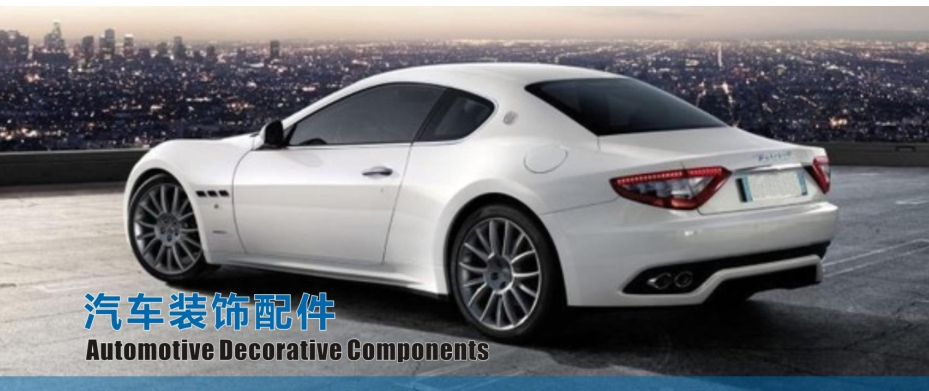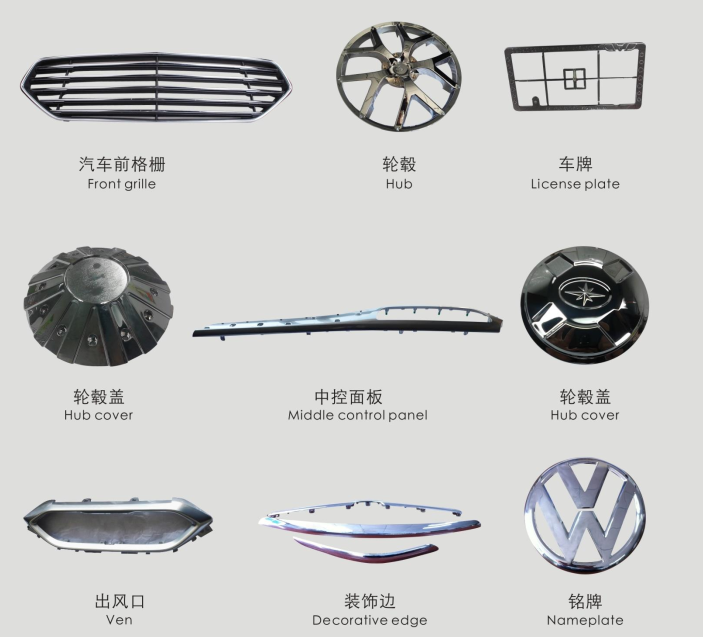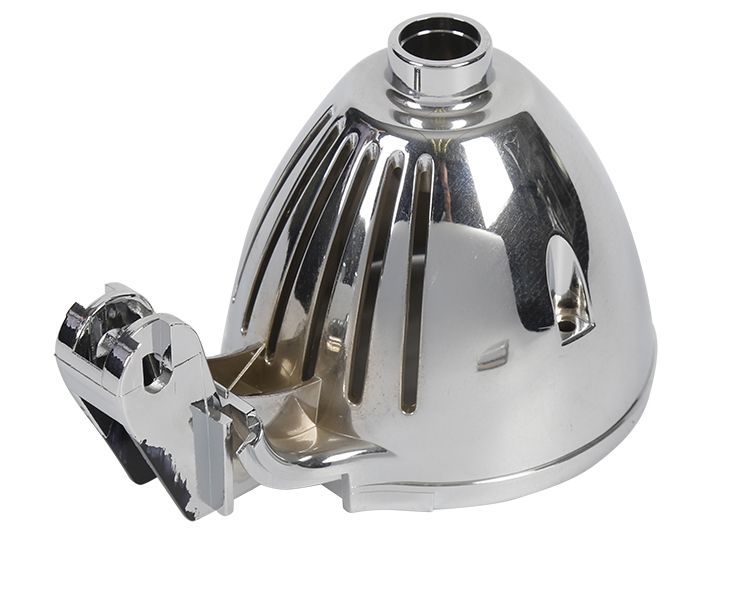Many cars today use decorative electroplating to add style to the exterior of the vehicle and to give it an overall premium feel. However, as the plated parts of a car are often exposed to the outdoors and are subjected to various environmental tests, the plating process and evaluation criteria for the exterior of a car need to be very strict. Generally, the type of plating used for automotive lamps is selected according to the conditions of use and is divided into four categories: Class U, for severe conditions of use, and for exterior parts; Class S, for strict conditions of use, and for exterior parts; Class A, for normal conditions of use, and for exterior parts; and Class B, for mild conditions of use, and for interior parts. The following is a detailed description of the plating process and test method for chrome plating on the tail lights of a Japanese car from Company A.

1-Type of plating
The type of plating used for the decoration of the lights of an A-series Japanese car is class S. The conditions of use are strict, the application is for exterior parts, and the type of material is plastic.
2 – Plating quality

2.1 Plating method
Electroplating is a method in which copper, nickel, chromium and other elements are electrolytically applied to the surface of the substrate to give it a metallic lustre. In addition, the nickel layer is subdivided into several plating methods. The plating method used for this lamp is 2 or 3 nickel + dispersion stress (nickel seal), micro-porous chromium. 2 nickel and 3 nickel, the thickness of the semi-glossy nickel layer is not less than 1/2 of the total thickness of the nickel layer.
2.2 Minimum thickness of the plating
The thickness is determined by the microscope method, but can also be determined by an electrolytic film thickness gauge. Alternatively, for chromium only, a fluorescent X-ray type film thickness gauge can be used. In principle, the minimum thickness of the plating should be measured. However, if the shape of the plated part makes the thickness of the plating uneven, the measuring area can be changed by agreement between the parties involved. Nickel plating can be used instead of copper plating for all substrates except zinc alloys and aluminium alloys. The thickness of the copper should be such that the appearance and hot and cold cycle properties are guaranteed. The thickness of the copper layer should be at least one times the thickness of the nickel layer at the point of measurement, although the substrate conditions such as shape, size and forming conditions may vary. The minimum thickness of nickel and chromium plating is also different depending on the application environment.
2.3 Appearance
Visual inspection in room light, 500mm from the test surface. The surface of the plating should be smooth and shiny, free from stains, bulges, wounds, cuts, exposed material, sand eyes, unsmoothness and other abnormalities. However, this does not apply to parts of the vehicle that cannot be visually inspected. The limit shall be determined by agreement between the parties concerned and shall be the extent to which the defects are not apparent when the whole vehicle is visually inspected at 50cm intervals in the sunlight.
2.4 Corrosion resistance
Saltwater spray test (SST): continuous according to JISZ2371 or ASTMB117. For S-grade and A-grade, no rusting without a flying stone test is considered acceptable. For plastic materials, the salt spray test (SST) is not required.
Corrodkote test: according to JISH8502 or ASTMB380. The optional method of preparing the Corrodkote bonding solution is as follows: 2.5 g of copper nitrate (Cu(NO3)2_3H2O), dissolved in a volumetric flask and accurately diluted to 500 ml with distilled water, and 2.50 g of ferric chloride (FeCl3_6H2O), dissolved in a second volumetric flask and accurately diluted to 500 ml with distilled water (when not in use). The ferric chloride solution should be stored in a dark place with a rubber or glass stopper) (The ferric chloride solution should not be stored for more than 2 weeks. Then measure exactly 7.0 ml of copper nitrate solution, 33.0 ml of ferric chloride solution and 10.0 ml of ammonium chloride solution, put the above solutions into a pouring beaker and add 30.0 g of porcelain clay and stir with a glass rod. The Corrodkote bonding solution should be ready to use. No rusting or discolouration can be seen visually at 50cm intervals. However, no localised corrosion of more than 10% should occur at least for other than U-grades. In the case of an application area of less than 25cm2, the corrosion rate of the whole shall not exceed 10%. For S-class plating process to promote weathering resistance test for 48 hours or more.
Skin corrosion resistance test (CASS): according to JISH8502 or ASTMB368. No rusting (surface rusting), discolouration etc. at 50cm intervals by visual inspection. For the S-class plating process, the skin film corrosion resistance test is 60h or more.
2.5 Hot and cold cyclability
For S grade, the base material is plastic material, according to the following test method for the hot and cold cycle, the hot and cold cycle is more than 4, after the test, the effective surface does not occur expansion, peeling, cutting phenomenon is qualified. Hot and cold cycle test method: The conditions in Table 6 are for 1 cycle, and in principle, the cycle is carried out after the plating has been left for more than 48 hours. Note (10) to be decided by agreement between the parties concerned.
2.6 Adhesion
The adhesion of plastic substrates is tested in accordance with the following test method, so that peeling between the substrate and the plating does not occur easily. However, the criteria for determination vary according to the test method and are subject to agreement between the parties involved. The method of JISH 8630 Annex 6 or ASTMB 533 is used as a benchmark. In principle, after the plating has been left for 48 hours, the test is carried out as follows: (1) Make a cross on the surface of the plating with a sharp-edged object that touches the substrate. (2) Lift the skin of the plating from the intersection side at an acute angle. (3) Pull up the lifted skin in a direction perpendicular to the plating surface. The plating adhesion of the plastic substrate is tested at a peel-off speed of 30mm/min, usually above 9.8N/cm, with a peel-off range of 10mm. The thickness of the plating must be measured in the strictest sense (e.g., 3σ method). That is, the average value of the plating thickness at the general measurement site (e.g., the centre line of the X management chart) is greater than 30% to 50% of the specified value.
2.7 Ductility
The ductility of glossy nickel plating, according to ASTMB490, must be above 0.1. The ductility of semi-glossy nickel plating, according to ASTMB490, must be above 0.4.
3 – Process conditions
3.12 Heavy nickel
(1) Implementation of 2 heavy nickel plating with a semi-glossy nickel plating on the lower layer and a glossy nickel plating on the upper layer.
(2) The rate of sulphur content in the plating is 0-0.005% for semi-glossy nickel plating and 0.05%-0.07% for glossy nickel plating.
3.23 Heavy nickel
(1) Intermediate nickel plating of 0.6μm or more in the middle of the semi-glossy nickel layer and the glossy nickel layer, which is the same as the 2 heavy nickel plating. (2) Intermediate nickel layer with a sulphur content of 0.1% or more.
3.3 Microporous electroplating of chromium (ordinary chromium)
(1) In the nickel layer below the chromium layer, non-electrically conductive microparticle co-precipitation nickel plating is carried out and a large number of tiny pores are produced in the chromium layer.
(2) The microporosity exceeds 2000/cm2.
4 – Conclusion
Due to the vast territory of China and the different weather conditions, it is a big test for the exterior plated parts of the car body, and it is one of the important issues for each vehicle factory and each parts factory to enhance the management of plating quality.

